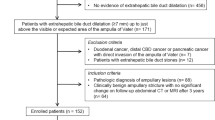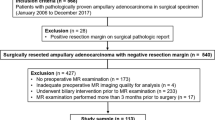Abstract
Purpose
To stratify and weigh the computed tomography (CT) imaging and clinical features differentiating a neoplastic ampullary obstruction from a non-neoplastic ampullary obstruction and to develop a nomogram for estimating individualized risk of neoplastic potential in patients with a suspected ampulla of Vater (AOV) lesion on CT.
Methods
135 patients (92 non-neoplastic and 43 neoplastic) with a suspected ampullary obstruction on a CT scan between February 2015 and May 2019 were included after the exclusion criteria were applied. Significant imaging and clinical findings of the neoplastic lesions were assessed using univariate and multivariate logistic regression analyses. Based on the significant variables in the multivariate analysis, a nomogram was developed to predict neoplastic potential in patients suspected of ampullary obstruction. The area under the receiver operating characteristic curve (AUC) was used to assess the diagnostic value in the external validation cohort (36 non-neoplastic and 13 neoplastic).
Results
The multivariate analysis revealed that the presence of an AOV mass (odds ratio (OR), 77.21; 95% confidence intervals (CI) 1.51–3950.38), AOV size > 12 mm (OR, 23.93; 95% CI 2.96–193.60), total bilirubin > 1.2 mg/dl (OR, 9.99; 95% CI 1.37–73.06) and age ≤ 63 years (OR, 7.52; 95% CI 1.33–42.48) were independent significant parameters that predicted a neoplastic lesion in the AOV. The AUC for the nomogram was 0.93 on the internal validation and 0.91 (95% CI 0.79–0.97) on the external validation.
Conclusions
A nomogram using imaging and clinical findings was useful to estimate a neoplastic ampullary obstruction in patients with a suspected AOV lesion on CT and suggests a further evaluation.





Similar content being viewed by others
References
Nikolaidis P, Hammond NA, Day K, et al. Imaging Features of Benign and Malignant Ampullary and Periampullary Lesions. 2014; 34:624-641
Kim YK, Kim CS, Han YM, Lee YH. Detection of liver malignancy with gadoxetic acid-enhanced MRI: is addition of diffusion-weighted MRI beneficial? Clinical radiology 2011; 66:489-496
Kaiser A, Jurowich C, Schönekäs H, Gebhardt C, Wünsch PJZfG. The adenoma-carcinoma sequence applies to epithelial tumours of the papilla of Vater. 2002; 40:913-920
Wiedmann M, Schoppmeyer K, Witzigmann H, Hauss J, Mössner J, Caca KJZfG. Current diagnostics and therapy for carcinomas of the biliary tree and gallbladder. 2005; 43:305-315
Jean M, Dua KJCgr. Tumors of the ampulla of Vater. 2003; 5:171-175
Bettschart V, Rahman M, Engelken F, Madhavan K, Parks R, Garden OJBjos. Presentation, treatment and outcome in patients with ampullary tumours. 2004; 91:1600-1607
Raman SP, Fishman EKJAJoR. Abnormalities of the distal common bile duct and ampulla: diagnostic approach and differential diagnosis using multiplanar reformations and 3D imaging. 2014; 203:17-28
Katabathina VS, Dasyam AK, Dasyam N, Hosseinzadeh KJR. Adult bile duct strictures: role of MR imaging and MR cholangiopancreatography in characterization. 2014; 34:565-586
Chang S, Lim JH, Choi D, Kim SK, Lee WJ. Differentiation of ampullary tumor from benign papillary stricture by thin-section multidetector CT. Abdominal Imaging 2008; 33:457-462
Angthong W, Jiarakoop K, Tangtiang KJJjor. Differentiation of benign and malignant ampullary obstruction by multi-row detector CT. 2018; 36:477-488
Qin X-L, Wang Z-R, Shi J-S, Lu M, Wang L, He Q-R. Utility of serum CA19-9 in diagnosis of cholangiocarcinoma: in comparison with CEA. World journal of gastroenterology 2004; 10:427-432
Li GJIJOC, MEDICINE E. Diagnostic value of liver function enzymes for choledocholithiasis. 2016; 9:13014-13020
La Greca G, Sofia M, Lombardo R, et al. Adjusting CA19-9 values to predict malignancy in obstructive jaundice: influence of bilirubin and C-reactive protein. World journal of gastroenterology 2012; 18:4150-4155
Bing D, Wang D-Y, Lan L, et al. Serum Bilirubin Level as a Potential Marker for the Hearing Outcome in Severe-Profound Bilateral Sudden Deafness. Otol Neurotol 2019; 40:728-735
Ha H, Nam A-R, Bang J-H, et al. Soluble programmed death-ligand 1 (sPDL1) and neutrophil-to-lymphocyte ratio (NLR) predicts survival in advanced biliary tract cancer patients treated with palliative chemotherapy. 2016; 7:76604
Kim TU, Kim S, Lee JW, et al. Ampulla of Vater: comprehensive anatomy, MR imaging of pathologic conditions, and correlation with endoscopy. 2008; 66:48-64
Cicchetti DV. Guidelines, criteria, and rules of thumb for evaluating normed and standardized assessment instruments in psychology. Psychological Assessment 1994; 6:284-290
Miyakawa S, Ishihara S, Takada T, et al. Flowcharts for the management of biliary tract and ampullary carcinomas. 2008; 15:7
Chung YE, Kim MJ, Kim HM. Differentiation of benign and malignant ampullary obstructions on MR imaging. Eur J Radiol 2011; 80:198
Inamoto K, Tanaka S, Yamazaki H, Suzuki E, Ishikawa YJRFadGdRudN. Computed tomography of carcinoma of the ampulla of Vater. 1982; 136:689-693
Skordilis P, Mouzas IA, Dimoulios PD, Alexandrakis G, Moschandrea J, Kouroumalis EJBs. Is endosonography an effective method for detection and local staging of the ampullary carcinoma? A prospective study. 2002; 2:1
Chen CH, Tseng LJ, Yang CC, Yeh YHJJocu. Preoperative evaluation of periampullary tumors by endoscopic sonography, transabdominal sonography, and computed tomography. 2001; 29:313-321
Midwinter M, Beveridge C, Wilsdon J, Bennett M, Baudouin C, Charnley RJBjoS. Correlation between spiral computed tomography, endoscopic ultrasonography and findings at operation in pancreatic and ampullary tumours. 1999; 86:189-193
Lee HS, Jang JS, Lee S, et al. Diagnostic Accuracy of the Initial Endoscopy for Ampullary Tumors. Clin Endosc 2015; 48:239-246
Grobmyer SR, Stasik CN, Draganov P, et al. Contemporary Results with Ampullectomy for 29 “Benign” Neoplasms of the Ampulla. Journal of the American College of Surgeons 2008; 206:466-471
Ivanovic AM, Alessandrino F, Maksimovic R, et al. Pathologic subtypes of ampullary adenocarcinoma: value of ampullary MDCT for noninvasive preoperative differentiation. 2017; 208:W71-W78
Amr B, Miles G, Shahtahmassebi G, Roobottom C, Stell DJCr. Systematic evaluation of radiological findings in the assessment of resectability of peri-ampullary cancer by CT using different contrast phase protocols. 2017; 72:691. e611-691. e617
Vlachou PA, Khalili K, Jang H-J, Fischer S, Hirschfield GM, Kim TKJR. IgG4-related sclerosing disease: autoimmune pancreatitis and extrapancreatic manifestations. 2011; 31:1379-1402
Bodily KD, Takahashi N, Fletcher JG, et al. Autoimmune pancreatitis: pancreatic and extrapancreatic imaging findings. 2009; 192:431-437
Jang KM, Kim SH, Lee SJ, Park HJ, Choi D, Hwang JJR. Added value of diffusion-weighted MR imaging in the diagnosis of ampullary carcinoma. 2013; 266:491-501
Alessandrino F, Souza D, Ivanovic AM, Radulovic D, Yee EU, Mortele KJJAi. MDCT and MRI of the ampulla of Vater (part II): non-epithelial neoplasms, benign ampullary disorders, and pitfalls. 2015; 40:3292-3312
Andersson M, Kostic S, Johansson M, Lundell L, Asztély M, Hellström MJAR. MRI combined with MR cholangiopancreatography versus helical CT in the evaluation of patients with suspected periampullary tumors: a prospective comparative study. 2005; 46:16-27
Siontis GCM, Tzoulaki I, Castaldi PJ, Ioannidis JPA. External validation of new risk prediction models is infrequent and reveals worse prognostic discrimination. Journal of Clinical Epidemiology 2015; 68:25-34
Steyerberg EW, Harrell FE, Jr. Prediction models need appropriate internal, internal & external, and external validation. Journal of Clinical Epidemiology 2016; 69:245-247
Author information
Authors and Affiliations
Corresponding author
Ethics declarations
Conflict of interest
All the authors report that they have no conflict of interest.
Additional information
Publisher's Note
Springer Nature remains neutral with regard to jurisdictional claims in published maps and institutional affiliations.
Supplementary Information
Below is the link to the Supplementary Information.
Rights and permissions
About this article
Cite this article
Jang, S.Y., Kim, J.S., Baek, S.Y. et al. Proposed nomogram predicting neoplastic ampullary obstruction in patients with a suspected ampulla of Vater lesion on CT. Abdom Radiol 46, 3128–3138 (2021). https://doi.org/10.1007/s00261-021-02975-3
Received:
Revised:
Accepted:
Published:
Issue Date:
DOI: https://doi.org/10.1007/s00261-021-02975-3




